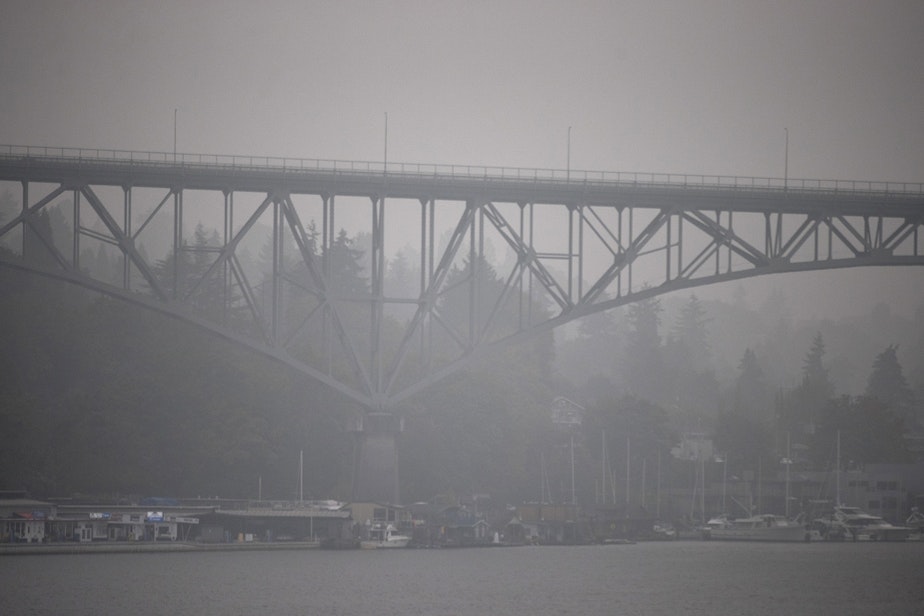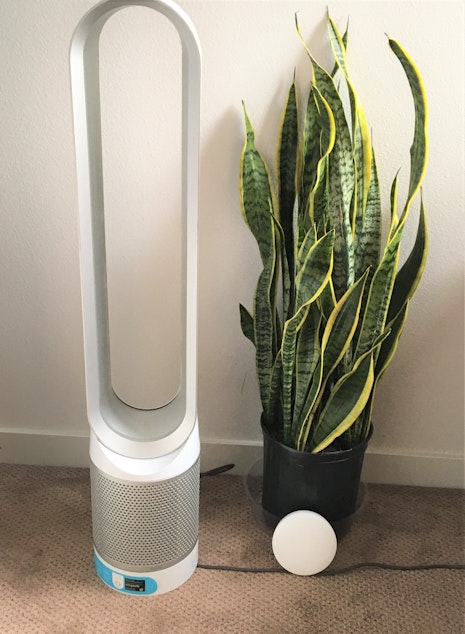The presence of wildfire smoke could have you feeling bad — and not for the reason you think

If you live in Pacific Northwest and have felt sluggish or generally unwell in the past week, it could be because of the smoke in the air — or it could be something else.
As Seattle residents have taken measures to keep wildfire smoke out of their homes, they say another problem has emerged: Increased carbon dioxide levels and decreased air flow in their homes.
In preparation for the wildfire smoke that blanketed the Seattle area last week, Sarah Schacht and her husband geared up with their air filters and indoor air quality monitors. They also cued up the air conditioning system they had installed in their three-story North Seattle residence back in April.
Schacht, who has asthma, said they wanted to ensure the smokey air didn't waft into their 1,100-square-foot townhome. But despite taking those precautions, headaches and exhaustion set in for the couple by Friday night.
"I got headaches that extended to my jaw and just felt deeply fatigued," Schacht said. "This air monitor was telling us we have dangerous levels of CO2."
At that point, one of Schacht's air quality monitors was registering just under 2,000 parts per million of carbon dioxide. A body of research indicates that at around 1,000 parts per million — the maximum recommend level for indoor spaces — carbon dioxide can affect human cognition and impair decision-making. Additionally, exposure to high levels of the compound can lead to the very symptoms Schacht experienced.
The smoke itself seemed like an unlikely culprit to Schacht, she said, considering their home was built in 2014 and is well-sealed.
Sponsored
"After we purchased the home, our builder told us we would have to run the exhaust fans in our home just to get carbon dioxide out, and to open our windows occasionally to get oxygen in because our home is that airtight," she said.
Carbon dioxide levels are generally higher indoors, where fresh air is less likely to be, than they are outdoors. The amount of carbon dioxide found indoors depends on variety of factors. Among them are the number of people present to exhale the compound, combustion byproducts from gas stoves or candle flames, for example, and the quality of ventilation in a building.
Schacht, in light of her revelation that her home contained too much carbon dioxide, created what she refers to as an "oxygen well" by allowing in outdoor air under controlled circumstances. But as the air flow in her home increases, so does the amount of smoke present.
"About every 18 to 24 hours, we have to basically take a section of our home where we open up a window there and run both of our air purifiers in that room, with the door to that area closed," she said, adding that it takes longer for the smoke to be filtered out than for the carbon dioxide levels to drop. Altogether, the process takes between 10 and 15 minutes.
"It's a balancing act to get enough [air] in, to be able to do our work from home and think and feel okay, and keep the smoke particulate out. You have to actually think about it and monitor it."
Sponsored
She and her husband also purchased nearly a dozen snake plants, which studies have found have enhanced oxygen producing and carbon dioxide eliminating capabilities in comparison to other plants.

Schacht isn't the only one who's observed high carbon dioxide levels in her home in recent days.
Grace Stahre and Beth Anderson, who also live in Seattle, told KUOW they too have experienced telltale symptoms of high carbon dioxide levels amid monitoring the indoor air quality.
"We noticed that when it gets above 1,200 parts per million that we start to feel sluggish," said Stahre, who lives in the Central District. "And some of us at different times will get headaches."
Sponsored
Anderson, who lives in Northeast Seattle, said she and her family felt similar physical effects. The highest carbon dioxide reading she's gotten thus far, she said, was 3,789 parts per million. However, her air quality monitor was still calibrating at that point, making it unclear how accurate the reading was. Anderson, like Schacht, took to allowing outside air into a single room to be filtered.
For her part, Stahre said she was disappointed in the lack of clear public health guidance for maintaining healthy oxygen levels in one's home during these times.
"I think that our state and local disaster preparedness has failed on this and people are not educated with what they need to do to stay safe," she said. "I think they're very few homes in the area are adequately protected."
Schacht echoed those sentiments.
“Suddenly, we’re all having to become HVAC and air quality experts in our homes," she said. "Trying to figure this out on your own is overwhelming and exhausting. I’m glad that we’re privileged enough to have these tools in our home, which certainly not everyone has access to.”
Sponsored
KUOW reached out to Public Health — Seattle & King County about the reports we heard of high indoor carbon dioxide levels.
"The balance of smoke irritation and CO2 build-up/low oxygen is difficult right now, particularly in an apartment or a single closed-off room," Spokesperson Doug Williams said in an email.
"In these situations, people might need to consider opening up the windows briefly if they notice it’s too stuffy or hot for comfort. Ideally, this would occur when there’s slightly cleaner air, or when there’s the availability of some sort of filtration happening, whether it’s a home’s HVAC system, a standalone filtration system or a DIY box fan filter."
It should be noted, however, that homemade box fan filters can potentially be a fire hazard. It is recommended that you don't leave the devices unattended and consider leaving some space between the filter and the fan motor.
Williams added that people with HVAC systems in their homes, who are experiencing high carbon dioxide levels, should consider taking them off the "recirculate" setting to keep allowing filtered outdoor air in.




